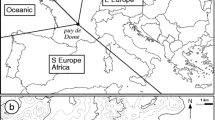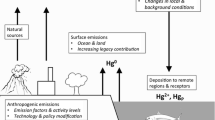Abstract
Purpose
Metals have often been identified as the main contributors to (eco)toxicological impacts in life cycle assessment (LCA) studies. Indeed, environmental fate models are generally unsuitable for these substances as they were developed for organics. Recent work has focused on improving these models by accounting for biogeochemical conditions (e.g., pH, redox potential, organic matter, etc.). These conditions often dictate metal bioavailability and (eco)toxicity. However, biogeochemical conditions cannot be integrated into an LCA framework due to a lack of high-resolution spatially differentiated factors describing the metal atmospheric pathway. This paper aims to derive worldwide source-receptor relationships for aerosol particles to ascertain the atmospheric mechanisms (i.e., dispersion, transport, and deposition) of metals (i.e., copper, cadmium, lead, nickel, chromium, and zinc) at a relatively high resolution.
Methods
We compared black carbon, sulfate, and nitrate aerosols according to the framework developed by Roy et al. Atmos Environ 62:74–81, (2012), which requires the results of a year-long (2005) GEOS-Chem (a three-dimensional global-scale tropospheric model) simulation. These aerosols are used as proxies since metals may sorb with them for short- and long-range transport. Source-receptor matrices (SRMs), whose elements are fate factors, were calculated at a global 2° × 2.5° resolution.
Results and discussion
The atmospheric fate of metals, as described by black carbon and sulfate aerosols, is similar while the atmospheric fate of nitrate is significantly different: 70% of the black carbon or sulfate emissions deposits within in a radius of less than 2000 km while this percentage drops to 40% with nitrate. Nitrate aerosol also showed the lowest agreement with EMEP modeling. Nitrate should not be considered as the optimal proxy. A case can be made for either sulfate or black carbon as proxies for metal; the latter is recommended as it showed the best agreement with EMEP modeling at the source location and similar agreement in the mid/long-range transport.
Conclusions
The SRMs outlined in this paper facilitate further modeling developments without having to run the underlying tropospheric model, thus paving the way for the assessment of the regional life cycle inventories of a global economy.


Similar content being viewed by others
References
Barret K, Berge E (1996) Transboundary air pollution in Europe: estimated dispersion of acidifying agents and of near surface ozone. In: EMEP (Ed.), The Norwegian Meteorological Institute
Baron P (2016) Generation and behavior of airborne particles (aerosols). Center for disease control and prevention (CDC). [Online] http://www.cdc.gov/niosh/topics/aerosols/pdfs/Aerosol_101.pdf
Bartnnicky J, Modzelewski H, Szewczyk-Bartnicka H, Saltbones J, Berge E, Bott A (1993) An Eulerian model for atmospheric transport of heavy metals over Europe: model development and testing. Det Norske Meteorologiske Institutt Technical report 117. http://emep.int/publ/reports/1993/DMNI_1993_TR_117.pdf
Bey I, Jacob D, Yantosca R, Logan J, Field B, Fiore A, Li Q, Liu H, Mickley L, Schultz M (2001) Global modeling of tropospheric chemistry with assimilated meteorology: model description and evaluation. J Geophys Res 106:23073–23905
Benedictow A, Fagerli H, Gauss M, Jonson JE, Nyìri A, Simpson D, Tsyro S, Valdebenito A, Vealiyaveetil S, Wind P, Aas W, Hjelbrekke A-G, Mareckova K, Wankmüller R, Harmens H, Cooper D, Norris D, SChröder W, Pesch R, Holy M (2009) Transboundary acidification, eutrophication and ground level ozone in Europe in 2007. In: EMEP (Ed.), EMEP status report. Norwegian Meteorological Institute
Bradl HB (ed) (2005) Heavy metals in the environment: origin, interaction and remediation. University of applied sciences trier, Neubrucke, Germany
Clarke AD et al (2004) Size distributions and mixtures of dust and black carbon aerosol in Asian outflow: Physiochemistry and optical properties. J Geophys Res 109:D15S09
Csavina J, Field J, Taylor MP, Gao S, Landázuri A, Betterton EA, Sáez AE (2012) A review on the importance of metals and metalloids in atmospheric dust and aerosol from mining operations. Sci Total Environ 433C:58–73
De Lurdes Dinis M, Fiúza A (2011) Exposure assessment to heavy metals in the environment: measures to eliminate or reduce the exposure to critical receptors. In: Simeonov L, Kochubovski M, Simeonova B (eds) Environmental heavy metal pollution and effects on child mental development. NATO Science for Peace and Security Series C: Environmental Security, vol 1. Springer, Dordrecht
Emmons LK, Walters S, Hess PG, Lamarque J-F, Pfister G, Filimore D, Granier C, Guenther A, Kinnison D, Laepple T, Orlando J, Tie X, Wiedinmyer C, Baughcum SL, Kloster S (2010) Description and evaluation of the model for ozone and related chemical tracers, version 4 (MOZART-4). Geosci Model Dev 3:43–67
Fang GC, Huang CS (2011) Atmospheric particulate and metallic elements (Zn, Ni, Cu, Cd and Pb) size distribution at three characteristic sampling sites. Environ Forensic 12(3):191–199
Finnveden G, Hauschild M, Ekvall T, Guinée J, Heijungs R, Hellweg S, Koehler A, Pennington D, Suh S (2009) Recent development in lifecycle assessment. J Environ Manag 91:1–21
Fu F, Wang Q (2011) Removal of heavy metal ions from wastewaters: a review. J Environ Manag 92(3):407–418
Gandhi N, Diamond M, van de Meet D, Huijbregts MAJ, Peijnenburg WJGM, Guinée J (2010) New method for calculating comparative toxicity potential of cationic metals in freshwater: application to copper, nickel, and zinc. Environ Sci Technol 44:5195–5201
Gandhi N, Huijbregts MAJ, van de Meeet D, Peijnenburg WJGM, Guinée J, Diamond ML (2011) Implications of geographic variability on comparative toxicity potentials of Cu, Ni and Zn in freshwaters of Canadian ecoregions. Chemosphere 8:268–277
Haye S, Slaveykova VI, Payet J (2007) Terrestrial ecotoxicity and effect factors of metals in life cycle assessment (LCA). Chemosphere 68:1489–1496
Hieu NT, Lee BK (2010) Characteristics of particulate matter and metals in the ambient air from a residential area in the largest industrial city in Korea. Atmos Res 98(2–4):526–537
Hoins U, Charlet L, Sticher H, (1993) Ligand effect on the adsorption of heavy metals: The sulfate — Cadmium — Goethite case. Water, Air, and Water pollution 68(1-2):241–255
Huijnen V, Williams J, van Weele M, van Noije T, Krol M, Dentener F, Segers A, Houweling S, Peters W, de Laat J, Boersma F, Bergamaschi P, van Velthoven P, Le Sager P, Eskes H, Alkemade F, Scheele R, Nédélec P, Patz H-W (2010) The global chemistry transport model TM5: description and evaluation of the tropospheric chemistry version 3.0. Geosci Model Dev 3:445–473
Jacob D, Liu H, Mari C, Yantosca R (2000) Harvard wet deposition scheme for GMI. Harvard University Atmospheric Chemistry Modeling Group
Kolodynska D, Krukoska J, Thomas P (2017) Comparison of sorption and desorption studies of heavy metal ions from biochar and commercial active carbon. Chem Eng J 307:353–363
Lamarque J-F, Emmons LK, Hess PG, Kinnison DE, Tilmes S, Heald CL, Holland EA, Lauritzen PH, Nen J, Orlando JJ, Rasch PJ, Tyndall GK (2012) CAM-Chem: description and evaluation of interactive atmospheric chemistry in the community earth system model. Geosci Model Dev 5:369–411
Neale RB et al (2012) Description of the NCAR community Atmosphere model (CAM 5.0). NCAR technical note. 289 pp. http://www.cesm.ucar.edu/models/cesm1.0/cam/docs/description/cam5_desc.pdf
NOAA National Climatic Data Center (2005) State of the Climate: Global Analysis for Annual 2005. www.ncdc.noaa.gov/sotc/global/2005/13 (accessed 05.06.11)
Olsen S, Brasseur GP, Wuebbles DJ, Barret SRH, Dang H, Eastham SD, Jacobson MZ, Khodayari A, Selkirk H, Sokolov A, Unger N (2013) Comparison of model estimates of the effects of aviation emissions on atmospheric ozone and methane. Geophys Res Lett 40:6004–6009
Pennington DW et al (2006) Risk and regulatory hazard-based toxicological effect indicators in life-cycle assessment (LCA). Hum Ecol Risk Assess 12(3):450–475
Potting J, Hauschild MZ (2006) Spatial differentiation in life cycle impact assessment: a decade of method development to increase the environmental realism in LCIA. Int J Life Cycle Assess 11:11–13
Pöschl U (2005) Atmospheric aerosols: composition, transformation, climate and health effects. Angew Chem Int Ed 44(46):7520–7540
Rasmussen PE (1998) Long-rage atmospheric transport of trace metals: the need for geoscience perspectives. Environ Geol 22(2–3):96–108
Reddington et al (2013) The mass and number size distributions of black carbon aerosol over Europe. Atmos Chem Phys 13:4917–4939
Reiley MC (2007) Science, policy, and trends of metals risk assessment at EPA: how understanding metals bioavailability has changed metals risk assessment at US EPA. Aquat Toxicol 84:292–298
Roy P-O, Huijbregts MAJ, Deschênes L, Margni M (2012) Spatially differentiated atmospheric source-receptor relationships for nitrogen oxides, sulfur oxides and ammonia emissions at the global scale for life cycle impact assessment. Atmos Environ 62:74–81
Roy P-O, Deschênes L, Margni M (2013) Uncertainty and spatial variability in characterization factors for aquatic acidification at the global scale. Int J Life Cycle Assess 19:882–890
Roy P-O, Deschênes L, Margni M (2014) Characterization factors for terrestrial acidification at the global scale: a systematic analysis of spatial variability and uncertainty. Sci Total Environ 500:270–276
Seibert P, Frank A (2003) Source receptor matrix calculation with a Lagrangian particle dispersion model in backward mode. Atmos Chem Phys 3:4515–4548
Strandesen M et al (2007) Fate and distribution modelling of metals in life cycle impact assessment. Ecol Model 203:327–338
Tchounwou PB, Yedjou CG, Patlolla AK, Sutton DJ (2012) Heavy metals toxicity and the environment. EXS 101:133–164
Travnikov O, Ilyin I (2005) Regional model MSCE-HM of heavy metal Transboundary air pollution in Europe. EMEP/MSC-E Technical Report 6/2005, p 59
Tuovinen J-P, Krüger O (1994) Re-evaluation of the local deposition correction in the Lagrangian EMEP model. In: EMEP/MSC-W Note 4/94 (Ed.), Norwegian Meteorological Institute
US Environmental Protection Agency (2005) Partition coefficient for metals in surface water, soil, and waste. EPA/600/R-05/074
US Environmental Protection Agency (2007) Framework for metal risk assessment. http://www.epa.gov/raf/metalsframework/pdfs/chaper3.pdf, 172 pp
Wang H, Rasch PJ, Easter RC, Singh B, Zhang R, Ma P-L, Qian Y, Ghan SJ, Beagley N (2014) Using an explicit emission tagging method in global modeling of source-receptor relationships for black carbon in the Arctic: variations, sources, and transport pathways. J Geophys Res Atmos 119:12888–12909
Yantosca B (2005) GEOS-CHEMv7–03-06 User’sGuide. HarvardUniversity. http://wwwas.harvard.edu/chemistry/trop/geos/doc/man/index.html (accessed 15.05.07)
Yasemin B, Zeki T (2007) Removal of heavy metals from aqueous solution by sawdust adsorption. J Environ Sci 19:160–166
Author information
Authors and Affiliations
Corresponding author
Additional information
Responsible editor: Masaharu Motoshita
Electronic supplementary material
ESM 1
(DOCX 420 kb)
Rights and permissions
About this article
Cite this article
Roy, PO., Bulle, C. & Deschênes, L. Global-scale atmospheric modeling of aerosols to assess metal source-receptor relationships for life cycle assessment. Int J Life Cycle Assess 24, 93–103 (2019). https://doi.org/10.1007/s11367-018-1508-y
Received:
Accepted:
Published:
Issue Date:
DOI: https://doi.org/10.1007/s11367-018-1508-y




